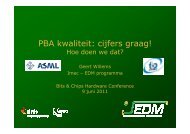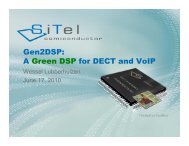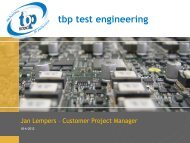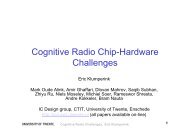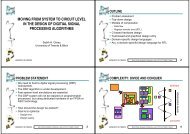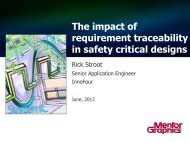EnOcean Dolphin - Hardware Conference
EnOcean Dolphin - Hardware Conference
EnOcean Dolphin - Hardware Conference
You also want an ePaper? Increase the reach of your titles
YUMPU automatically turns print PDFs into web optimized ePapers that Google loves.
ISO/IEC 14543-3-10<br />
a wireless standard optimised for<br />
Energy Harvesting<br />
Green. Smart. Wireless.<br />
John Corbett<br />
Director <strong>EnOcean</strong> GmbH UK
Wireless Sensing Technology saves resources<br />
Every 10 million wireless switches & sensors installed instead<br />
of wired devices can save :<br />
50,000 miles of cable<br />
3,000 tons copper / 7,100 tons PVC with 20,000 tons of CO2<br />
Thousands of man years of installation time<br />
Page 2
The design of wireless Energy Harvesting devices<br />
Wireless monitoring and control system using batteries<br />
have be available for some time.<br />
But batteries are costly and not eco friendly needing:-<br />
Tracking<br />
Monitoring<br />
Stocking<br />
Access & Replacement<br />
Disposal<br />
Wireless batteryless solutions are now achievable<br />
through use of innovative energy harvesting<br />
techniques<br />
Page 3
Types of ambient harvesters<br />
Switches<br />
Thermostats<br />
gas sensors<br />
pirs etc...<br />
Page 4
<strong>EnOcean</strong> Wireless Standard<br />
High Reliability<br />
License free 868 and 315 MHz band with 1% duty cycle<br />
Radio design for immunity against interference<br />
Multiple telegram with checksum maximize reliability<br />
Short telegrams generate low collision probability with high sensor density<br />
Full Coverage<br />
10 mW and receiver sensitivity allow 10-30m in buildings (300m line of<br />
sight)<br />
Repeater available for simple coverage extension<br />
Prepared for wireless network structures<br />
Page 5
ISO/IEC 14543-3-10 – a new International<br />
Standard<br />
ISO/IEC 14543-3-10 Information technology – Home Electronic Systems<br />
(HES)<br />
Part 3-10: Wireless Short-Packet (WSP) protocol optimized for<br />
energy harvesting -- Architecture and lower layer protocols<br />
The only wireless standard developed for ultra low energy consumption<br />
suitable for use with energy harvesting<br />
Ratified and published by International Electro technical Commission (IEC) –<br />
leading global organization for international standards for all electrical,<br />
electronic and related technologies. Completely open standard can be<br />
downloaded at www.iso.org<br />
Page 6
<strong>EnOcean</strong> – a new International Standard<br />
The <strong>EnOcean</strong> Alliance standardizes the<br />
application level (interoperability)<br />
The ISO standard offers physical layer,<br />
data link layer and network layer<br />
Page 7
ISO Format<br />
Standard Layer Services Data Units<br />
Application<br />
<strong>EnOcean</strong> Equipment profiles EEP<br />
RPC/RMCC Handling<br />
DATA<br />
Not defined in the standard<br />
Presentation<br />
Radio Telegram Processing<br />
Encryption<br />
DATA<br />
Session<br />
NOT USED<br />
Transport<br />
Smart Ack<br />
Remote Management<br />
TELEGRAM / MESSAGE<br />
Destination addressed telegrams<br />
( Encapsulation/Decapsulation)<br />
Network<br />
Switch telegram conversion<br />
TELEGRAM<br />
(RORG and STATUS processing)<br />
ISO/IEC 14543<br />
Specification<br />
Data Link Layer<br />
Repeating (STATUS processing)<br />
Subtelegram Structure<br />
Hash algorithms<br />
Subtelegram Timing<br />
SUBTELEGRAM<br />
Listen before talk<br />
Physical<br />
Encoding/Decoding (INV and SYNC)<br />
Wireless receiving/transmitting<br />
BITS / FRAME<br />
Page 8
ISO layer Details<br />
Physical layer<br />
Data transmitted on either 315 MHz or 868.3 MHz<br />
125 kBit/s data Amplitude Shift Keying (ASK).<br />
One bit duration is 8 µs.<br />
transmitted in frames as a bit by bit serial sequence<br />
A frame consists of the preamble (PRE), the start-of-frame sequence (SOF), the encoded bytes (with inverse<br />
(INV) and synchronization (SYNC) bits), and the end-of-frame sequence (EOF).<br />
Data description<br />
The communication protocol is packet based and the data units can be<br />
Frame , Subtelegram or Telegram<br />
A subtelegram is the result of a decoding process, in which control (PRE, SOF, INV and EOF) and synchronization<br />
information are removed from the frame.<br />
The subtelegrams are handled in the data link layer.<br />
The protocol is designed to work mostly as a unidirectional protocol<br />
without handshaking. To ensure transmission reliability three identical<br />
subtelegrams are transmitted within a certain time range.<br />
Page 9
ISO layer details<br />
Data link layer<br />
The subtelegram is transferred to the data link layer<br />
data integrity of the subtelegram is checked.<br />
subtelegram timing is based on an algorithm which makes sure that<br />
subtelegram collisions in the air are as low as possible.<br />
listen before talk (LBT) technique is used where possible .<br />
Network layer<br />
conversion between switch and normal telegrams<br />
repeating process, for range extension<br />
targeting process if the telegram is addressed (normal = broadcast)<br />
Page 10
<strong>EnOcean</strong> Technology<br />
IPR: Intellectual Property Rights<br />
ISO: International Organization for Standardization<br />
IEC: International Electro technical Commission<br />
EEP: <strong>EnOcean</strong> Equipment Profiles<br />
RF: Radio Frequency<br />
Page 11
<strong>EnOcean</strong> Wireless Sensor Network<br />
System Architecture with uni- and bi-directional communication<br />
Page 12
System Concept<br />
Self-powered Sensor<br />
TRANSMIT ONLY<br />
Unidirectional<br />
• Self-powered radio switch<br />
• Self-powered room temp.<br />
sensor (with presence signals)<br />
• etc.<br />
PTM & STM<br />
Actuator<br />
UNIDIRECTIONAL<br />
Line powered<br />
• Switching actuator<br />
• Dimmer<br />
• etc.<br />
RCM<br />
Sensor<br />
BIDIRECTIONAL<br />
Line / battery powered<br />
• Sensor measurement cycle<br />
times within ms range<br />
• Sensor with routing/repeating<br />
capabilities (AMR, fire<br />
detector)<br />
TCM300<br />
Self-powered Sensor<br />
SMART ACK<br />
Receive data time slot<br />
• Room thermostat with display<br />
• Remote control with signal<br />
reception acknowledge<br />
• etc. STM300<br />
Actuator<br />
BIDIRECTIONAL<br />
Line powered<br />
• Central units and Gateways<br />
• Actuator with repeating or<br />
routing capabilities<br />
• etc.<br />
TCM<br />
Wireless Actuator<br />
SMART ACK<br />
Harvester / Battery powered<br />
• Heating valve actuator<br />
• etc.<br />
STM300<br />
Communication Path<br />
Page 13
2 way comms is possible with harvesting devices<br />
sd Smart ACK with Repeater - Operating<br />
S<br />
Energy Harvesting<br />
sensor<br />
S<br />
PM<br />
Repeater<br />
C<br />
Controller<br />
{Is Post Master}<br />
Data()<br />
Data Reply()<br />
Save Acknowledge<br />
to Mailbox()<br />
On during this<br />
very short time<br />
interval is the<br />
receiver of S<br />
turn on to get an<br />
“ack“<br />
opt data ack<br />
[sensor wants ack]<br />
Data Reclaim()<br />
Data Acknowledge()<br />
time<br />
Page 14
The <strong>EnOcean</strong> Chip Specification<br />
Specific System-on-chip that integrates<br />
<strong>EnOcean</strong> wireless standard<br />
868 MHz (R&TEE) and 315 MHz (FCC)<br />
Processor & control functions<br />
Comprehensive peripherals<br />
Application programmable API<br />
Energy & sensor management<br />
Ultra-low-power WDT, Voltage Limiter, Threshold<br />
Detector and RAM0<br />
Superior Low Energy Need<br />
Deep Sleep Timer Mode<br />
Flywheel Sleep Mode<br />
Short Term Sleep Mode<br />
Standby Mode<br />
CPU Mode<br />
TX (868MHz, 6dBm)<br />
RX (868MHz)<br />
~220nA<br />
~720nA<br />
~10µA<br />
~1.4mA<br />
~4mA<br />
~24mA<br />
~33mA<br />
Page 15
Charge management<br />
Low<br />
Resistance,<br />
Low<br />
Leakage<br />
Low Leakage , Super<br />
Cap or PAS ( Poly<br />
Acenic Semiconductor<br />
Page 16
Current Security ID Authentication<br />
• Standard <strong>EnOcean</strong> ID<br />
• Every telegram sent contains a 32bit ID<br />
identifying the sender<br />
• Security measures to protect against<br />
misuse<br />
• Unique Module ID<br />
<br />
<br />
ID management and burning at manufacturing site<br />
<strong>EnOcean</strong> firmware ensures a unique Chip ID that<br />
cannot be replicated<br />
• Special Purpose ID<br />
<br />
<br />
<br />
pre-programmed BaseID<br />
up to 128 IDs from BaseID+0 .. BaseID+127<br />
BaseID can be modified up to 10 times<br />
Page 17
SECURITY New Enhancements<br />
• Rolling Code – Fraud Resistant<br />
against replay attack<br />
• Copy & Paste attack<br />
• Copy & Change attack<br />
• Change rolling code and use message<br />
authentication<br />
• Encryption – Tap Proof against<br />
eavesdropper<br />
• Read out sensor data<br />
• Encrypted data “unreadable” for<br />
eavesdropper<br />
Page 18
Protocol constrains<br />
• Telegram payload<br />
• Max. 13 bytes<br />
• Typ. 1 – 4 bytes<br />
• 90 % of energy harvesting<br />
transmitters are unidirectional<br />
• Harvester and transmitter are highly<br />
optimized<br />
• Energy budget<br />
Page 19
Security Algorithm overview<br />
> Titel der Präsentation > Autor > 05.06.2013
<strong>EnOcean</strong> radio protocol stack and security layer<br />
- Teach In Telegrams<br />
Wire<br />
Application<br />
Air<br />
<strong>EnOcean</strong> Equipment Profiles<br />
Remote Management<br />
Smart Acknowledge<br />
<strong>EnOcean</strong> Serial<br />
Protocol<br />
Security<br />
<strong>EnOcean</strong> Radio<br />
Protocol<br />
RS232 – UART 868.3, 315, 902<br />
MHz (Radio)
Encryption in Radio Telegrams – Data<br />
En- \ decapsulation of non-secure RORG<br />
Non-secure<br />
RORG DATA TXID STATUS<br />
Secure<br />
0x31 RORG ENC_DATA RLC CMAC TXID STATUS<br />
VAES<br />
Variable AES 128<br />
AES-CBC<br />
AES 128 Cipherblock<br />
chaining
<strong>EnOcean</strong> System Architecture<br />
Energy Harvesting<br />
Self-powered wireless sensors from <strong>EnOcean</strong><br />
collect and save the tiniest amounts of energy<br />
from their environment<br />
Enocean Modules<br />
Easy to integrate<br />
For fast and low-cost equipment development<br />
868 , 315, 902 MHz to meet various country<br />
requirements<br />
Software<br />
A Powerful & Easy to Use Operation System<br />
For modular and versatile, user-friendly<br />
integration in applications<br />
Enocean Wireless - ISO Standard<br />
ISO/IEC 14543-3-10 Information technology Home<br />
Electronic Systems (HES)<br />
Page 23
Module Platforms<br />
Page 24
Energy Harvesting Wireless Switch Modules<br />
PTM 210 – ideal for energy harvesting wireless switches<br />
ECO 200 and PTM 330 – the perfect combination for unique<br />
switch applications<br />
Page 25
Energy Harvesting Wireless Sensor Modules<br />
STM 300 – ideal for bidirectional energy harvesting wireless sensors or<br />
innovative actuators<br />
STM 3xy series – ideal for a variety of energy harvesting wireless<br />
sensors, such as window contacts, temperature or humidity sensors<br />
Page 26
Wireless Receiver & Transceiver Modules<br />
TCM 300, TCM 310, TCM 320 and USB 300 – ideal for permanently<br />
powered system components<br />
Page 27
Mechanical Energy (1): –<br />
Linear Movement and Button Push<br />
"Plug & Play" Light Switch Module<br />
Contact nipples<br />
for switch rocker<br />
identification<br />
Rotation axis for<br />
push buttons or<br />
switch rockers<br />
Power converter,<br />
Processor, HF radio<br />
and antenna<br />
Energy bow on<br />
both device sides<br />
Electrodynamic<br />
Energy Converter<br />
Page 28
Mechanical Energy -<br />
Mechanical Energy Harvesting Product Examples<br />
Page 29
Light Energy – Light Intensity<br />
Indoor<br />
Outdoor<br />
Thin Film Solar Cell:<br />
1cm 2 active Area<br />
Power, from Low Cost Thin Film Solar Cells<br />
Page 30
Light Energy - Typical Illumination Intensities<br />
School<br />
Blackboard<br />
General class room<br />
500 - 1000 lx<br />
300 - 500 lx<br />
Office Building<br />
PC workplace<br />
<strong>Conference</strong> room<br />
Corridor<br />
200 - 500 lx<br />
300 - 700 lx<br />
50 - 100 lx<br />
Hotel<br />
Reception<br />
Restaurant<br />
Staircase<br />
300 - 700 lx<br />
150 - 300 lx<br />
50 - 150 lx<br />
Page 31
Using a Peltier Element for power<br />
The voltage generated from Peltier<br />
elements are very low requiring<br />
innovative DC-DC conversion<br />
n<br />
~ 100<br />
20 mV 3 V<br />
ECT 310<br />
ECT 310<br />
DC/DC<br />
Converter<br />
The ECT310, is a low-cost ultra low<br />
voltage DC/DC converter that uses a<br />
highly innovative blocking oscillator<br />
design.<br />
2+ Kelvin temperature difference on the<br />
Peltier device gives around 20 mV to 50<br />
mV corresponding to an output voltage<br />
range between 3V to 4 V from the ECT<br />
310.<br />
Page 32
Thermo-powered Wireless Actuator<br />
~100 μW energy available at 7 Kelvin temperature difference<br />
Actuator Application<br />
Enough energy is available to<br />
power some intermittently powered<br />
actuators !<br />
Page 33
Inductive Harvesting<br />
Inductive Harvesting using the STM300 – This CT from Cloud<br />
Buildings charges every sec from the induced current from a cable<br />
and sends a reading every other second<br />
Page 34
M2M End Nodes<br />
Using Energy Harvesting devices as end<br />
nodes is ideal for M2M wireless networks<br />
where, typically, there is an ‘always on’<br />
device being used such as a GPRS or an<br />
internet gateway.<br />
TCP/IP<br />
GPRS /<br />
Ethernet<br />
M2M wireless networks benefit from energy<br />
harvesting technology<br />
eliminates the need for battery replacement,<br />
making them ideal in hostile or inaccessible<br />
areas .<br />
Give a step change in longevity<br />
Environmentally friendly as no toxic chemicals<br />
are used or disposed of<br />
Page 35
Typical Gateway uses<br />
Page 36
<strong>EnOcean</strong> Link<br />
Data -><br />
Action -><br />
Temperature = 25 °C<br />
Humidity = 80 %<br />
Illumination = 200 lx<br />
etc.<br />
6. Provides as output decoded<br />
values<br />
5. Decodes raw data into real<br />
values<br />
Data -><br />
Action -><br />
4. Extracts raw Sensor Data<br />
3. Handles all Security<br />
relevant tasks<br />
Data -><br />
Data -><br />
… 0x21, 0x25, 0xAA, 0x48, 0x44 ...<br />
2. Recognises Messages<br />
1. Gets an input UART Datastream<br />
Preliminary<br />
Page 37
<strong>EnOcean</strong> Sensor Network<br />
Smart<br />
Sensor<br />
Smart<br />
Actuator<br />
Line<br />
powered<br />
Actuator<br />
Solar<br />
Sensor<br />
GATEWAY<br />
Local<br />
Controller<br />
Actuator<br />
Actuator /<br />
Receiver<br />
Kinetic<br />
powered<br />
Switch<br />
Thermoelectric<br />
powered<br />
Sensor<br />
Bidirectional<br />
Transceiver<br />
devices<br />
Battery-less<br />
Transmitter<br />
devices<br />
Page 38
<strong>EnOcean</strong> in Lighting and Energy control systems<br />
Page 39
Over 250,000 Buildings "enabled by <strong>EnOcean</strong>"<br />
Commercial / Offices<br />
Medical / Assisted Living<br />
Industrial<br />
Residential<br />
Hospitality Historical Retail<br />
Schools (K-12, Universities)<br />
Page 40
<strong>EnOcean</strong> Alliance<br />
Non for profit legal entity<br />
Owned by “promoters”<br />
Standardization of radio interface<br />
Global marketing of solution<br />
200+ Customers have integrated<br />
<strong>EnOcean</strong>’s solution and created<br />
more than 850 interoperable<br />
products!<br />
200+ members from all<br />
Award Winning<br />
Green Technology<br />
Page 41
Support by <strong>EnOcean</strong><br />
Application Engineering<br />
<strong>Hardware</strong> & Software<br />
Located in Germany & North America<br />
www.enocean.com/support/<br />
Knowledge Base & System Specification<br />
www.enocean.com/knowledge-base/<br />
Tutorial Videos<br />
Application Notes<br />
www.enocean.com/application-notes/<br />
Social Media<br />
www.enocean.com/en/social-media/<br />
Magazine Perpetuum<br />
http://www.enocean.com/en/perpetuum/<br />
Page 42
Thank you for<br />
your attention.<br />
Page 43<br />
John Corbett<br />
john.corbett@enocean.com
Harvesting Heat differentials<br />
Heat<br />
PELTIER / SEEBECK effect<br />
A thermoelectric device creates a voltage when<br />
-<br />
- N +<br />
P<br />
+<br />
there is a different temperature on 2 junctions of 2<br />
metals, a property discovered by Seebeck in 1821.<br />
Conversely when a voltage is applied, it creates a<br />
temperature difference (known as the Peltier effect).<br />
Cold ( heat sink)<br />
A heat source will drive electrons<br />
in the n-type element toward the<br />
cooler region, creating a current<br />
through the circuit.<br />
Holes in the p-type element will<br />
then flow in the direction of the<br />
current. The current can then be<br />
used to power a load.<br />
There are a number of low cost Peltier elements<br />
available and these can be used ‘in reverse’ as<br />
generators for small wireless monitors.<br />
Standard thermoelectric modules manufactured today<br />
consist of P- and N-doped bismuth-telluride<br />
semiconductors sandwiched between two metallised<br />
ceramic plates<br />
Page 44





